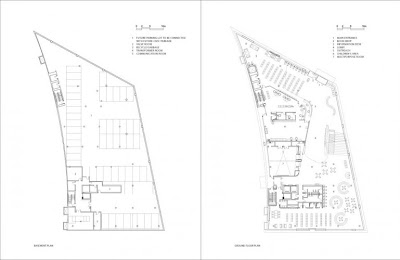In recent times libraries are no longer conceived as simple facilities for storing books but they also fulfill a social role, enhancing the community relations. Such is the case of the Peckham Library in London , the Sendai Mediatheque by Toyo Ito and the Seattle Central Library, a project by OMA. In this post we will discuss some features of the new Surrey Library, designed as a space for research and as well as for social interaction.
Surrey is the second largest city in the Metro Vancouver conglomerate. With its 460,000 inhabitants, it has been long overdue in its economic development. However, this situation is trying to be reversed through the development of mega-projects that seek to revitalize the downtown area as well as improve the quality of life of its inhabitants.
The flagship of this development is the new Surrey City Centre Library, designed by Bing Thom Architects, who a decade ago had already carried out another successful project in the vicinity, named Central City, a vibrant mix use facility that combines public space, a university and a shopping center.
The library has an iconic profile and its sloping walls express the dynamism which also characterizes the interior space. Capitalizing on the complicated geometry of the plot, this building of sloping walls, pronounced keel and large bluish windows resembles a ship.
Photo courtesy of eVolo
"The building design evolved out of the need to provide a space for reading, studying, and above all, gathering as a community"
But how to understand a library function nowadays? Given the versatility of today's electronic media, the book as an object is giving up its importance as the core element of the library. By contrast, the books now share their protagonism with their readers, who also establish communication and carry out discussions between them.
For this reason the building includes, aside of 100,000 volumes, several areas for assembly of up to 120 people, a learning center, collective and individual reading areas, computer classrooms, a meditation room, a teen room and children's play areas. In addition, the spaces are flexibly organized and they successfully have housed social events for the community.
Basement and first level
Second and third level
Fourth level and roof plan.
Sections. Images courtesy of Bing Thom Architects.
This idea has led to conceive the library on the basis of two types of interrelated spaces: the more public areas, which form a large plaza, amphitheater and terraces where the community can socialize and interact; and those more private ones, containing collections of books and more intimate spaces for research and study.
This duality of spaces is further characterized by the type of lighting. The large central courtyard is lit by large windows which establish an open dialogue with the outside. The terraces and parapets incorporate dynamism into space and promote, at the same time, visual integration between the various levels of the library.
A small amphitheater accompanying the stair was finished in simple materials such as exposed concrete and wood. This space brings together the community to medium-sized social activities, or functions just a place to sit and read together.
Views and detail of the amphitheater, which brings together the community for social activities
This space is crowned by a trapezoidal skylight. Interestingly, it is not a typical open skylight, but rather a sort of ring around a trapeze, which allows a diffuse control of natural lighting. This detail provides technical and structural challenges, in order to sustain this great trapeze that seems to be floating, surrounded by a transparent aura.
Another challenge was the construction of the walls, which describe a curved path while being inclined outwards, thus expressing dynamism as well as providing shadow outside.
Despite its complexity, a computerized study allowed efficiently calculate the structure. Also, by means of a special type of concrete a fine finish was achieved, without the need of coating. These features have allowed the library to qualify as LEED "green" building.
The designers involved the community not only as the final users of the building but as actors that participated in the design process, through the use of social networks and collective workshops. The architects have even teamed up with high school students in order to create and discuss some of the furniture inside.
The library is part of a larger urban area that is currently under construction and we hope to share with you in the future when finished.
SEE ALSO
- LIBRARIES
- National Library of Children's Literature. Tokyo, Japan. Tadao Ando (2002)
- Seattle Central Library. Rem Koolhaas & OMA
- Sendai Mediatheque, Sendai, Japan. Toyo Ito (2001)
- Tama Art University Library, Tokyo, Japan. Toyo Ito (2007)




























